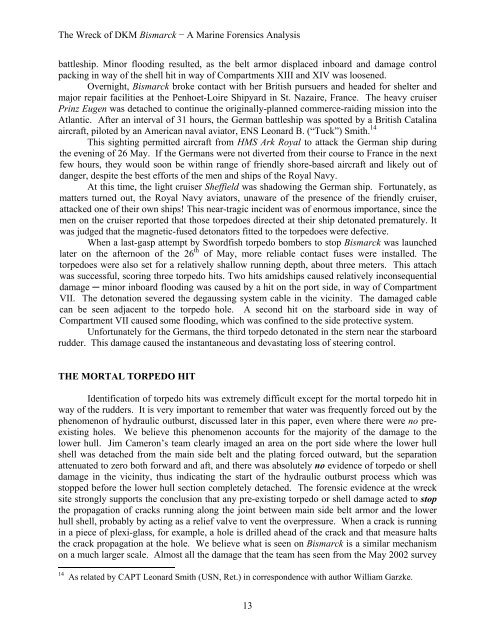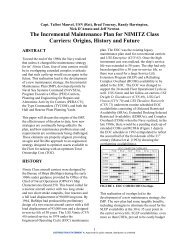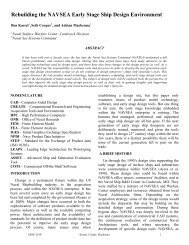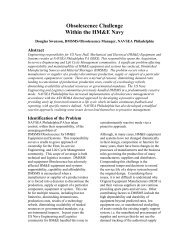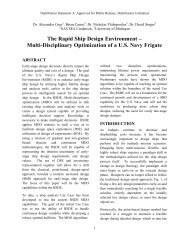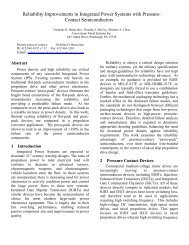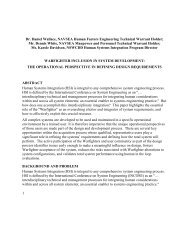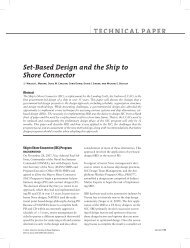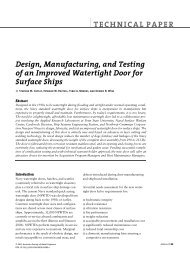The Wreck of DKM Bismarck − A Marine Forensics Analysis 1 The ...
The Wreck of DKM Bismarck − A Marine Forensics Analysis 1 The ...
The Wreck of DKM Bismarck − A Marine Forensics Analysis 1 The ...
Create successful ePaper yourself
Turn your PDF publications into a flip-book with our unique Google optimized e-Paper software.
<strong>The</strong> <strong>Wreck</strong> <strong>of</strong> <strong>DKM</strong> <strong>Bismarck</strong> <strong>−</strong> A <strong>Marine</strong> <strong>Forensics</strong> <strong>Analysis</strong><br />
battleship. Minor flooding resulted, as the belt armor displaced inboard and damage control<br />
packing in way <strong>of</strong> the shell hit in way <strong>of</strong> Compartments XIII and XIV was loosened.<br />
Overnight, <strong>Bismarck</strong> broke contact with her British pursuers and headed for shelter and<br />
major repair facilities at the Penhoet-Loire Shipyard in St. Nazaire, France. <strong>The</strong> heavy cruiser<br />
Prinz Eugen was detached to continue the originally-planned commerce-raiding mission into the<br />
Atlantic. After an interval <strong>of</strong> 31 hours, the German battleship was spotted by a British Catalina<br />
aircraft, piloted by an American naval aviator, ENS Leonard B. (“Tuck”) Smith. 14<br />
This sighting permitted aircraft from HMS Ark Royal to attack the German ship during<br />
the evening <strong>of</strong> 26 May. If the Germans were not diverted from their course to France in the next<br />
few hours, they would soon be within range <strong>of</strong> friendly shore-based aircraft and likely out <strong>of</strong><br />
danger, despite the best efforts <strong>of</strong> the men and ships <strong>of</strong> the Royal Navy.<br />
At this time, the light cruiser Sheffield was shadowing the German ship. Fortunately, as<br />
matters turned out, the Royal Navy aviators, unaware <strong>of</strong> the presence <strong>of</strong> the friendly cruiser,<br />
attacked one <strong>of</strong> their own ships! This near-tragic incident was <strong>of</strong> enormous importance, since the<br />
men on the cruiser reported that those torpedoes directed at their ship detonated prematurely. It<br />
was judged that the magnetic-fused detonators fitted to the torpedoes were defective.<br />
When a last-gasp attempt by Swordfish torpedo bombers to stop <strong>Bismarck</strong> was launched<br />
later on the afternoon <strong>of</strong> the 26 th <strong>of</strong> May, more reliable contact fuses were installed. <strong>The</strong><br />
torpedoes were also set for a relatively shallow running depth, about three meters. This attach<br />
was successful, scoring three torpedo hits. Two hits amidships caused relatively inconsequential<br />
damage ─ minor inboard flooding was caused by a hit on the port side, in way <strong>of</strong> Compartment<br />
VII. <strong>The</strong> detonation severed the degaussing system cable in the vicinity. <strong>The</strong> damaged cable<br />
can be seen adjacent to the torpedo hole. A second hit on the starboard side in way <strong>of</strong><br />
Compartment VII caused some flooding, which was confined to the side protective system.<br />
Unfortunately for the Germans, the third torpedo detonated in the stern near the starboard<br />
rudder. This damage caused the instantaneous and devastating loss <strong>of</strong> steering control.<br />
THE MORTAL TORPEDO HIT<br />
Identification <strong>of</strong> torpedo hits was extremely difficult except for the mortal torpedo hit in<br />
way <strong>of</strong> the rudders. It is very important to remember that water was frequently forced out by the<br />
phenomenon <strong>of</strong> hydraulic outburst, discussed later in this paper, even where there were no preexisting<br />
holes. We believe this phenomenon accounts for the majority <strong>of</strong> the damage to the<br />
lower hull. Jim Cameron’s team clearly imaged an area on the port side where the lower hull<br />
shell was detached from the main side belt and the plating forced outward, but the separation<br />
attenuated to zero both forward and aft, and there was absolutely no evidence <strong>of</strong> torpedo or shell<br />
damage in the vicinity, thus indicating the start <strong>of</strong> the hydraulic outburst process which was<br />
stopped before the lower hull section completely detached. <strong>The</strong> forensic evidence at the wreck<br />
site strongly supports the conclusion that any pre-existing torpedo or shell damage acted to stop<br />
the propagation <strong>of</strong> cracks running along the joint between main side belt armor and the lower<br />
hull shell, probably by acting as a relief valve to vent the overpressure. When a crack is running<br />
in a piece <strong>of</strong> plexi-glass, for example, a hole is drilled ahead <strong>of</strong> the crack and that measure halts<br />
the crack propagation at the hole. We believe what is seen on <strong>Bismarck</strong> is a similar mechanism<br />
on a much larger scale. Almost all the damage that the team has seen from the May 2002 survey<br />
14 As related by CAPT Leonard Smith (USN, Ret.) in correspondence with author William Garzke.<br />
13


